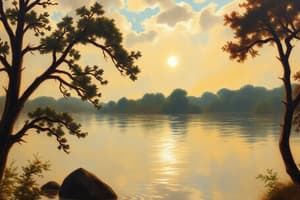Podcast
Questions and Answers
Why is blood glucose monitoring important for managing hyperglycemia?
Why is blood glucose monitoring important for managing hyperglycemia?
- To track trends and identify patterns (correct)
- To determine the best meal plans
- To reduce insulin doses
- To prevent the need for physical activity
How can exercise influence blood glucose control?
How can exercise influence blood glucose control?
- Raising blood glucose levels
- Decreasing insulin sensitivity
- Improving insulin sensitivity (correct)
- Increasing the risk of complications
What is a potential risk of high-intensity exercise in individuals with diabetes?
What is a potential risk of high-intensity exercise in individuals with diabetes?
- Ketoacidosis
- Diabetic neuropathy
- Hypoglycemia
- Hyperglycemia (correct)
What is the recommended timing for checking blood glucose levels in relation to exercise?
What is the recommended timing for checking blood glucose levels in relation to exercise?
What is a major risk factor for women with gestational diabetes?
What is a major risk factor for women with gestational diabetes?
Which type of diabetes is characterized by an immune system-mediated destruction of pancreatic beta cells?
Which type of diabetes is characterized by an immune system-mediated destruction of pancreatic beta cells?
Which type of diabetes requires daily insulin injections for management in most cases?
Which type of diabetes requires daily insulin injections for management in most cases?
What are some classic symptoms associated with severe hyperglycemia in advanced stages of type 2 diabetes mellitus?
What are some classic symptoms associated with severe hyperglycemia in advanced stages of type 2 diabetes mellitus?
Which of the following is a common symptom of type 2 diabetes mellitus as it progresses over years?
Which of the following is a common symptom of type 2 diabetes mellitus as it progresses over years?
Define Diabets Mellitus
Define Diabets Mellitus
What are the acute complications of diabetes
What are the acute complications of diabetes
What are the manifestations (signs, symptoms and effects) of hyperglycaemia
What are the manifestations (signs, symptoms and effects) of hyperglycaemia
What role does the kidney play during hyperglycaemia
What role does the kidney play during hyperglycaemia
Symptoms of Hyperglycaemia and their cause.
Symptoms of Hyperglycaemia and their cause.
Define the diagnostic criteria for diabetes in Aus
Define the diagnostic criteria for diabetes in Aus
What is insulin and whats its role
What is insulin and whats its role
Blood glucose elevations in combination with poorly managed diabetes, increases one's risk of what 3 acute and chronic health issues?
Blood glucose elevations in combination with poorly managed diabetes, increases one's risk of what 3 acute and chronic health issues?
What factor independently causes some degree of insulin resistance?
What factor independently causes some degree of insulin resistance?
Define insulin resistance
Define insulin resistance
Exercise is not contraindicated in someone experiencing diabetes ketoacidosis
Exercise is not contraindicated in someone experiencing diabetes ketoacidosis
Define diabetic ketoacidosis
Define diabetic ketoacidosis
Which type of diabetes is more likely to cause ketoacidosis
Which type of diabetes is more likely to cause ketoacidosis
What are symptoms of ketoacidosis
What are symptoms of ketoacidosis
Why would you see elevated ketones in the blood?
Why would you see elevated ketones in the blood?
What is the result of the breakdown of fat for energy when there is a lack of CHOs?
What is the result of the breakdown of fat for energy when there is a lack of CHOs?
What chemical byproduct is a direct result of low glucose?
What chemical byproduct is a direct result of low glucose?
What is ketosis
What is ketosis
What causes hyperosmolar non-ketotic syndrome and why?
What causes hyperosmolar non-ketotic syndrome and why?
Symptoms of hyperosmolar non-ketotic syndrome
Symptoms of hyperosmolar non-ketotic syndrome
What intrinsic and extrinsic factors increase risk and are attribute to hypogylcaemia
What intrinsic and extrinsic factors increase risk and are attribute to hypogylcaemia
Hypoglycaemia can occur either during exercise or hours to days later?
Hypoglycaemia can occur either during exercise or hours to days later?
What sort of exercise generally triggers late onset of hypoglycaemia
What sort of exercise generally triggers late onset of hypoglycaemia
Why can hypoglycaemia be delayed after exercise?
Why can hypoglycaemia be delayed after exercise?
how does the body combat a decrease in blood glucose?
how does the body combat a decrease in blood glucose?
How does the release of epinephrine and glucagon effect blood glucose?
How does the release of epinephrine and glucagon effect blood glucose?
what are the 2 categories of symptoms of hypoglycaemia?
what are the 2 categories of symptoms of hypoglycaemia?
Name some adrenergic symptoms
Name some adrenergic symptoms
name some neuroglycopaenic symptoms
name some neuroglycopaenic symptoms
What are cardiovascualr consequences of hypoglycaemia?
What are cardiovascualr consequences of hypoglycaemia?
What is hypoglycaemia unawareness
What is hypoglycaemia unawareness
Consequences of Hypoglycaemia unawareness
Consequences of Hypoglycaemia unawareness
What do you do if you think you have a patient who is currently hypoglycaemic?
What do you do if you think you have a patient who is currently hypoglycaemic?
What factor of diabetes is the leading mechanism in the development of chronic complications?
What factor of diabetes is the leading mechanism in the development of chronic complications?
Name macrovascular diseases that result from chronic hyperglycaemia
Name macrovascular diseases that result from chronic hyperglycaemia
name microvascular complications resulting from chronic hyperglycaemia
name microvascular complications resulting from chronic hyperglycaemia
What is peripheral neuropathy and its symptoms
What is peripheral neuropathy and its symptoms
Define autonomic neuropathy
Define autonomic neuropathy
What is cardiovascular autonomic neuropathy manifested by?
What is cardiovascular autonomic neuropathy manifested by?
Summarize the complications of diabetes
Summarize the complications of diabetes
What are some possible macrovascular complications
What are some possible macrovascular complications
While people with T2D may remain unsymptommatic, what are the classic signs and symptoms seen, especially in those who are undiagnosed
While people with T2D may remain unsymptommatic, what are the classic signs and symptoms seen, especially in those who are undiagnosed
What 3 things should you inquire about before commencing exercise testing to prevent acute complications?
What 3 things should you inquire about before commencing exercise testing to prevent acute complications?
Which of the following is incorrect?
Which of the following is incorrect?
Which of the following is true of T1D?
Which of the following is true of T1D?
The most common initial treatment for T2D is what?
The most common initial treatment for T2D is what?
Which of the following is incorrect regarding T2D?
Which of the following is incorrect regarding T2D?
Which of the following ketone values represents medically significant ketoacidosis?
Which of the following ketone values represents medically significant ketoacidosis?
In which of the following circumstances is exercise contraindicated?
In which of the following circumstances is exercise contraindicated?
Hypoglycemia is most likely to occur in which of the following situations?
Hypoglycemia is most likely to occur in which of the following situations?
Which of the following is a macrovascular complication of diabetes
Which of the following is a macrovascular complication of diabetes
Which of the following is the primary cause of adrenergic hypoglycaemic symptoms
Which of the following is the primary cause of adrenergic hypoglycaemic symptoms
How should you treat confirmed hypoglycaemia?
How should you treat confirmed hypoglycaemia?
What is the most common initial sign or symptom of peripheral neuropathy
What is the most common initial sign or symptom of peripheral neuropathy
What would you expect for a typical patient with cardiovascular autonomic neuropathy?
What would you expect for a typical patient with cardiovascular autonomic neuropathy?
A fasting blood glucose of 6.2mmol/L indicates which of the following?
A fasting blood glucose of 6.2mmol/L indicates which of the following?
In which of the following circumstances is exercise contraindicated?
In which of the following circumstances is exercise contraindicated?
Which of the following is contraindicated in proliferative retinopathy
Which of the following is contraindicated in proliferative retinopathy
Study Notes
Hyperglycemia Control: Managing Blood Glucose through Exercise and Monitoring
Hyperglycemia, a condition characterized by high blood glucose levels, is a common issue for individuals with diabetes. Effective management of hyperglycemia is crucial for maintaining overall health and preventing complications. This article focuses on two subtopics within hyperglycemia control: blood glucose monitoring and exercise routines.
Blood Glucose Monitoring
Blood glucose monitoring is a vital aspect of managing hyperglycemia. Regular monitoring allows individuals to assess their glucose levels and take appropriate actions to maintain optimal blood glucose levels. This can involve adjusting insulin doses, modifying meal plans, or engaging in physical activity. Continuous glucose monitoring systems (CGMs) can provide real-time glucose readings, enabling users to track trends and identify patterns that may indicate the need for intervention.
Exercise Routines
Exercise is a powerful tool in managing hyperglycemia. Regular physical activity can help lower blood glucose levels, improve insulin sensitivity, and reduce the risk of complications associated with diabetes. The type and timing of exercise can influence blood glucose control.
Exercise Intensity and Timing
Moderate exercises, such as walking or cycling, can cause a slow drop in blood glucose levels, while some exercises, like running or football, may cause blood glucose levels to rise. Exercise-induced hyperglycemia is more common in type 1 diabetes, and purposeful insulin omission or malfunctioning infusion sets can contribute to this condition. Individuals with type 2 diabetes may also experience increases in blood glucose after aerobic or resistance exercise, particularly if they administer too little insulin for meals before activity.
Exercise Types and Benefits
Aerobic exercise, such as walking, swimming, or cycling, can lower blood glucose levels, especially when performed during postprandial periods with the usual insulin dose. High-intensity interval training (HIIT) and resistance exercise can also be beneficial, especially when performed before or after meals. However, very intense activities like sprinting or heavy powerlifting may promote hyperglycemia, especially if starting glucose levels are elevated.
Exercise and Hypoglycemia
Hypoglycemic events can occur within 6-15 hours post-exercise, and the risk can extend to 48 hours. Reducing daily basal insulin doses and adjusting prandial insulin doses can help minimize the risk of nocturnal hypoglycemia. Using continuous glucose monitoring and adjusting insulin doses based on glucose trends can also be helpful.
Exercise Recommendations
Individuals with type 1 diabetes should check blood glucose levels before and during exercise, adjust insulin doses accordingly, and monitor glucose levels after exercise to prevent hypos. Drinking plenty of water and wearing diabetes ID necklaces or bracelets while exercising are also essential safety measures.
Conclusion
Proper blood glucose monitoring and adhering to an appropriate exercise routine are crucial for managing hyperglycemia in diabetes. Regular monitoring allows for timely intervention, while exercise can help lower blood glucose levels and improve overall health. The timing, intensity, and type of exercise can all play a role in blood glucose control. Consulting with healthcare professionals and adhering to personalized exercise and monitoring plans can help individuals with diabetes effectively manage their blood glucose levels and reduce the risk of complications.
Studying That Suits You
Use AI to generate personalized quizzes and flashcards to suit your learning preferences.





